香港大学:Solving Polynomial Equations
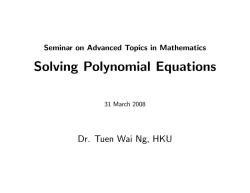
Seminar on Advanced Topics in Mathematics Solving Polynomial Equations 31 March 2008 Dr.Tuen Wai Ng,HKU
Seminar on Advanced Topics in Mathematics Solving Polynomial Equations 31 March 2008 Dr. Tuen Wai Ng, HKU
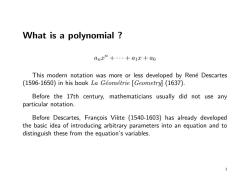
What is a polynomial anxn+·+a1x+a0 This modern notation was more or less developed by Rene Descartes (1596-1650)in his book La Geometrie [Geometry](1637). Before the 17th century,mathematicians usually did not use any particular notation. Before Descartes,Francois Viete (1540-1603)has already developed the basic idea of introducing arbitrary parameters into an equation and to distinguish these from the equation's variables. 1
What is a polynomial ? anx n + · · · + a1x + a0 This modern notation was more or less developed by Ren´e Descartes (1596-1650) in his book La G´eom´etrie [Geometry] (1637). Before the 17th century, mathematicians usually did not use any particular notation. Before Descartes, Fran¸cois Vi`ete (1540-1603) has already developed the basic idea of introducing arbitrary parameters into an equation and to distinguish these from the equation’s variables. 1
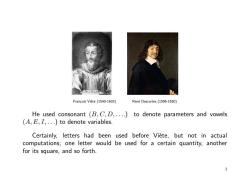
Francois Viete (1540-1603) Rene Descartes (1596-1650) He used consonant (B,C,D,....)to denote parameters and vowels (A,E,I,...)to denote variables. Certainly,letters had been used before Viete,but not in actual computations;one letter would be used for a certain quantity,another for its square,and so forth. 2
Fran¸cois Vi`ete (1540-1603) Ren´e Descartes (1596-1650) He used consonant (B, C, D, . . ..) to denote parameters and vowels (A, E, I, . . .) to denote variables. Certainly, letters had been used before Vi`ete, but not in actual computations; one letter would be used for a certain quantity, another for its square, and so forth. 2
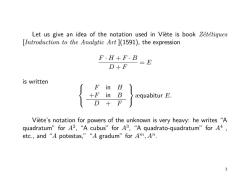
Let us give an idea of the notation used in Viete is book Zetetiques [Introduction to the Analytic Art ](1591),the expression F·H+F·B D+F 二E is written {} aequabitur E. Viete's notation for powers of the unknown is very heavy:he writes "A quadratum”forA2,“A cubus'”forA3,“A quadrato--quadratum”forA4, etc,and“A potestas,.”“A gradum"for Am,A". 3
Let us give an idea of the notation used in Vi`ete is book Z´et´etiques [Introduction to the Analytic Art ](1591), the expression F · H + F · B D + F = E is written F in H +F in B D + F æquabitur E. Vi`ete’s notation for powers of the unknown is very heavy: he writes “A quadratum” for A2 , “A cubus” for A3 , “A quadrato-quadratum” for A4 , etc., and “A potestas,” “A gradum” for Am, An. 3
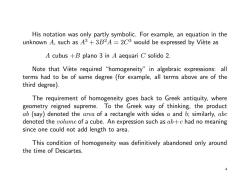
His notation was only partly symbolic.For example,an equation in the unknown A,such as A3+3B2A =203 would be expressed by Viete as A cubus +B plano 3 in A aequari C solido 2. Note that Viete required "homogeneity"in algebraic expressions:all terms had to be of same degree (for example,all terms above are of the third degree). The requirement of homogeneity goes back to Greek antiquity,where geometry reigned supreme.To the Greek way of thinking,the product ab (say)denoted the area of a rectangle with sides a and b;similarly,abc denoted the volume of a cube.An expression such as ab+c had no meaning since one could not add length to area. This condition of homogeneity was definitively abandoned only around the time of Descartes. 4
His notation was only partly symbolic. For example, an equation in the unknown A, such as A3 + 3B2A = 2C 3 would be expressed by Vi`ete as A cubus +B plano 3 in A aequari C solido 2. Note that Vi`ete required “homogeneity” in algebraic expressions: all terms had to be of same degree (for example, all terms above are of the third degree). The requirement of homogeneity goes back to Greek antiquity, where geometry reigned supreme. To the Greek way of thinking, the product ab (say) denoted the area of a rectangle with sides a and b; similarly, abc denoted the volume of a cube. An expression such as ab+c had no meaning since one could not add length to area. This condition of homogeneity was definitively abandoned only around the time of Descartes. 4
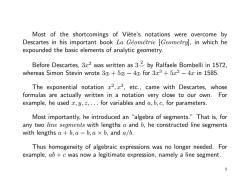
Most of the shortcomings of Viete's notations were overcome by Descartes in his important book La Geometrie [Geometry,in which he expounded the basic elements of analytic geometry. Before Descartes,32 was written as 32 by Ralfaele Bombelli in 1572, whereas Simon Stevin wrote 3+50-40 for 3x3+5x2-4x in 1585. The exponential notation 22,23,etc.,came with Descartes,whose formulas are actually written in a notation very close to our own.For example,he used x,y,2,...for variables and a,b,c,for parameters. Most importantly,he introduced an "algebra of segments."That is,for any two line segments with lengths a and b,he constructed line segments with lengths a +b,a-b,a x b,and a/b. Thus homogeneity of algebraic expressions was no longer needed.For example,ab+c was now a legitimate expression,namely a line segment. 5
Most of the shortcomings of Vi`ete’s notations were overcome by Descartes in his important book La G´eom´etrie [Geometry], in which he expounded the basic elements of analytic geometry. Before Descartes, 3x 2 was written as 3 2 ^ by Ralfaele Bombelli in 1572, whereas Simon Stevin wrote 3°3 + 5°2 − 4°1 for 3x 3 + 5x 2 − 4x in 1585. The exponential notation x 2 , x3 , etc., came with Descartes, whose formulas are actually written in a notation very close to our own. For example, he used x, y, z, . . . for variables and a, b, c, for parameters. Most importantly, he introduced an “algebra of segments.” That is, for any two line segments with lengths a and b, he constructed line segments with lengths a + b, a − b, a × b, and a/b. Thus homogeneity of algebraic expressions was no longer needed. For example, ab + c was now a legitimate expression, namely a line segment. 5
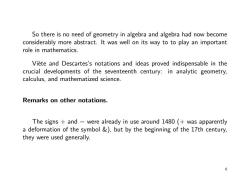
So there is no need of geometry in algebra and algebra had now become considerably more abstract.It was well on its way toto play an important role in mathematics. Viete and Descartes's notations and ideas proved indispensable in the crucial developments of the seventeenth century:in analytic geometry, calculus,and mathematized science. Remarks on other notations. The signs and-were already in use around 1480 (was apparently a deformation of the symbol &)but by the beginning of the 17th century, they were used generally. 6
So there is no need of geometry in algebra and algebra had now become considerably more abstract. It was well on its way to to play an important role in mathematics. Vi`ete and Descartes’s notations and ideas proved indispensable in the crucial developments of the seventeenth century: in analytic geometry, calculus, and mathematized science. Remarks on other notations. The signs + and − were already in use around 1480 (+ was apparently a deformation of the symbol &), but by the beginning of the 17th century, they were used generally. 6
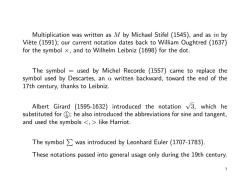
Multiplication was written as M by Michael Stifel (1545),and as in by Viete (1591);our current notation dates back to William Oughtred (1637) for the symbol x,and to Wilhelm Leibniz (1698)for the dot. The symbol used by Michel Recorde (1557)came to replace the symbol used by Descartes,an a written backward,toward the end of the 17th century,thanks to Leibniz. Albert Girard (1595-1632)introduced the notation v3,which he substituted for he also introduced the abbreviations for sine and tangent, and used the symbols <,like Harriot. The symbol was introduced by Leonhard Euler (1707-1783) These notations passed into general usage only during the 19th century. 7
Multiplication was written as M by Michael Stifel (1545), and as in by Vi`ete (1591); our current notation dates back to William Oughtred (1637) for the symbol ×, and to Wilhelm Leibniz (1698) for the dot. The symbol = used by Michel Recorde (1557) came to replace the symbol used by Descartes, an α written backward, toward the end of the 17th century, thanks to Leibniz. Albert Girard (1595-1632) introduced the notation √ 3, which he substituted for 1°3 ; he also introduced the abbreviations for sine and tangent, and used the symbols like Harriot. The symbol P was introduced by Leonhard Euler (1707-1783). These notations passed into general usage only during the 19th century. 7
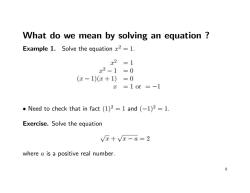
What do we mean by solving an equation Example 1.Solve the equation z2 -1. x2=1 x2-1=0 (x-1)(x+1) =0 x=10r=-1 Need to check that in fact (1)2=1 and (-1)2=1. Exercise.Solve the equation Vx+Vx-a=2 where a is a positive real number. 8
What do we mean by solving an equation ? Example 1. Solve the equation x 2 = 1. x 2 = 1 x 2 − 1 = 0 (x − 1)(x + 1) = 0 x = 1 or = −1 • Need to check that in fact (1)2 = 1 and (−1)2 = 1. Exercise. Solve the equation √ x + √ x − a = 2 where a is a positive real number. 8
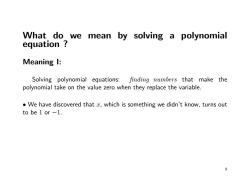
What do we i mean by solving a polynomial equation Meaning I: Solving polynomial equations:finding numbers that make the polynomial take on the value zero when they replace the variable. We have discovered that x,which is something we didn't know,turns out to be 1 or-1. 9
What do we mean by solving a polynomial equation ? Meaning I: Solving polynomial equations: finding numbers that make the polynomial take on the value zero when they replace the variable. • We have discovered that x, which is something we didn’t know, turns out to be 1 or −1. 9
按次数下载不扣除下载券;
注册用户24小时内重复下载只扣除一次;
顺序:VIP每日次数-->可用次数-->下载券;
- 香港大学:Games and the Mathematical Mind.pdf
- 香港大学:Seminar on Applications of Mathematics - Voting.pdf
- 香港大学:From Nash to Nash’s Game Theory.pdf
- 香港大学:博弈高手——浅论约翰·纳殊的诺具尔得理论.pdf
- 香港大学:谈情说数——跟爱情有关的数学.pdf
- 香港大学:《数趣漫话》谈情说数——跟爱情有关的数学.pdf
- 香港大学:拍卖中寻对策(PPT讲稿).pdf
- 佛山大学(佛山科学技术学院):2017版数学与应用数学(师范)专业理论课教学大纲汇编(合集).pdf
- 中国科学技术大学:几何建模与处理基础(PPT讲稿)细分曲线(主讲:刘利刚).pdf
- 同济大学:《高等数学》课程教学资源(预习PPT讲稿)第八章 向量代数与空间解析几何 第四节 空间直线及其方程.ppsx
- 同济大学:《高等数学》课程教学资源(预习PPT讲稿)第八章 向量代数与空间解析几何 第六节 空间曲线及其方程.ppsx
- 同济大学:《高等数学》课程教学资源(预习PPT讲稿)第八章 向量代数与空间解析几何 第五节 曲面及其方程.ppsx
- 同济大学:《高等数学》课程教学资源(预习PPT讲稿)第八章 向量代数与空间解析几何 第二节 数量积、向量积、混合积.ppsx
- 同济大学:《高等数学》课程教学资源(预习PPT讲稿)第八章 向量代数与空间解析几何 第三节 平面及其方程.ppsx
- 同济大学:《高等数学》课程教学资源(预习PPT讲稿)第八章 向量代数与空间解析几何 第一节 向量及其线性运算.ppsx
- 同济大学:《高等数学》课程教学资源(预习PPT讲稿)第三章 微分中值定理与导数的应用 第四节 函数的单调性与曲线的凹凸性.pps
- 同济大学:《高等数学》课程教学资源(预习PPT讲稿)第三章 微分中值定理与导数的应用 第五节 函数的极值与最大最小值.pps
- 同济大学:《高等数学》课程教学资源(预习PPT讲稿)第三章 微分中值定理与导数的应用 第七节 曲率.pps
- 同济大学:《高等数学》课程教学资源(预习PPT讲稿)第三章 微分中值定理与导数的应用 第三节 泰勒公式.pps
- 同济大学:《高等数学》课程教学资源(预习PPT讲稿)第三章 微分中值定理与导数的应用 第二节 洛必达法则.pps
- 香港大学:Solving Polynomial Equations(2006.12.5).pdf
- ON-LINE LIST COLOURING OF RANDOM GRAPHS.pdf
- 西安电子科技大学:《线性代数》课程教学资源(PPT课件)线性代数机算与应用.ppt
- 西安电子科技大学:《线性代数》课程教学资源(讲义)线性代数讲义(共六章,主讲:李仁先).pdf
- 中国科学技术大学:《离散数学》课程教学资源(PPT课件讲稿)第一部分 数理逻辑 第一章 命题逻辑(主讲:肖明军).ppt
- 中国科学技术大学:《离散数学》课程教学资源(PPT课件讲稿)第一部分 数理逻辑 第二章 谓词逻辑.ppt
- 中国科学技术大学:《离散数学》课程教学资源(PPT课件讲稿)第二部分 集合论 第三章 集合代数.ppt
- 中国科学技术大学:《离散数学》课程教学资源(PPT课件讲稿)第二部分 集合论 第四章 二元关系.ppt
- 中国科学技术大学:《离散数学》课程教学资源(PPT课件讲稿)第二部分 集合论 第五章 函数.ppt
- 中国科学技术大学:《离散数学》课程教学资源(PPT课件讲稿)第二部分 集合论 第六章 集合的基数.ppt
- 中国科学技术大学:《离散数学》课程教学资源(PPT课件讲稿)第三部分 代数结构 第七章 代数系统.ppt
- 中国科学技术大学:《离散数学》课程教学资源(PPT课件讲稿)第三部分 代数结构 第八章 群论.ppt
- 中国科学技术大学:《离散数学》课程教学资源(PPT课件讲稿)第三部分 代数结构 第九章 环与域.ppt
- 中国科学技术大学:《离散数学》课程教学资源(PPT课件讲稿)第三部分 代数结构 第十章 格与布尔代数.ppt
- 中国科学技术大学:《离散数学》课程教学资源(PPT课件讲稿)第三部分 图论 第十一章 图的基本概念.ppt
- 中国科学技术大学:《离散数学》课程教学资源(PPT课件讲稿)第三部分 图论 第十二章 树.ppt
- 中国科学技术大学:《离散数学》课程教学资源(PPT课件讲稿)第三部分 图论 第十三章 几种特殊的图.ppt
- 《力学》课程教学资源(数学工具)力学数学预备知识——微积分初步.pdf
- 《力学》课程教学资源(数学工具)矢量分析与场论初步.pdf
- 《力学》课程教学资源(数学工具)张量的定义.pdf
